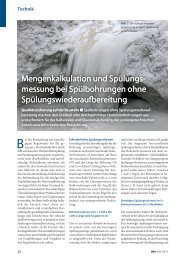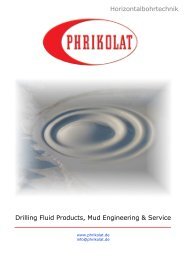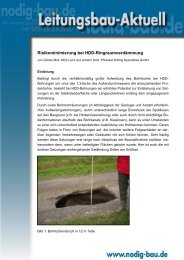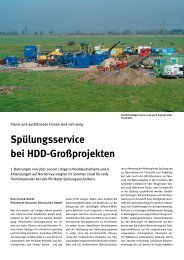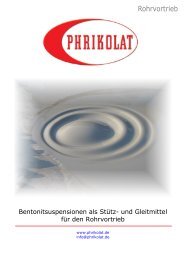56" Pipeline Installation Exceeds 1000m for the First Time - Phrikolat
56" Pipeline Installation Exceeds 1000m for the First Time - Phrikolat
56" Pipeline Installation Exceeds 1000m for the First Time - Phrikolat
Create successful ePaper yourself
Turn your PDF publications into a flip-book with our unique Google optimized e-Paper software.
HDD Method in Russia<br />
56" <strong>Pipeline</strong> <strong>Installation</strong> <strong>Exceeds</strong><br />
<strong>1000m</strong> <strong>for</strong> <strong>the</strong> <strong>First</strong> <strong>Time</strong><br />
By Oliver Knopf, <strong>Phrikolat</strong> Drilling Specialties GmbH<br />
Pre-assembled “tunnel“ ND 1400 on dollies.<br />
The Russian company VIS-MOS managed to undercross <strong>the</strong> river<br />
Sheksna with a 450t Prime Drilling rig on a stretch longer than<br />
<strong>1000m</strong>.<br />
The plan was to also cross a length of 1043m<br />
beneath <strong>the</strong> river Sheksna with a 56" gas line<br />
within <strong>the</strong> bounds of <strong>the</strong> project „North-European<br />
Gas <strong>Pipeline</strong>“, section Grjasowez – Wyborg.<br />
Although a 56" gas line has never be<strong>for</strong>e<br />
been installed at such diatances using <strong>the</strong><br />
HDD method and <strong>the</strong> soil conditions were very<br />
complicated indeed, <strong>the</strong> decision was made<br />
to under-cross <strong>the</strong> river using <strong>the</strong> directional<br />
horizontal drilling technique. The river, situated<br />
approximately 400 km away from Moscow,<br />
was to be undercrossed in nor<strong>the</strong>rn direction<br />
by <strong>the</strong> Russian company JV VIS-MOS/LLC. The<br />
contractor of <strong>the</strong> entire project is JSC „Yamal-<br />
GazInvest“.<br />
Foreword<br />
Directional horizontal bores exceeding a length<br />
of <strong>1000m</strong> are quite common <strong>the</strong>se days, when<br />
even bores of 3000m in one go have been<br />
achieved already. But this is still an extraordi-<br />
nary challenge <strong>for</strong> pipe diameters<br />
of 56" (1420mm);<br />
pipes of this size have only<br />
ever been installed in shorter<br />
lengths with <strong>the</strong> HDD method<br />
by two or three companies<br />
worldwide. In order to<br />
pull a 56" steel pipe (1420<br />
x 25.8mm) into a bore hole<br />
established by means of<br />
<strong>the</strong> horizontal drilling technique,<br />
you need a bore hole<br />
diameter of at least 1.80m<br />
(71"). The soil volume transported<br />
out of <strong>the</strong> bore hole<br />
amounts to approx. 2.5m³<br />
per running metre, this<br />
makes a total of roughly<br />
2650m³ of soil on <strong>the</strong> complete<br />
stretch of 1043m. Stored<br />
on a plane surface, you<br />
could use this soil to build a<br />
Foundling, brought to <strong>the</strong> surface<br />
by <strong>the</strong> ND 1600 reamer.
i UmweltBau 1 | 08 Horizontalbohren 35<br />
10m high rectangular block with a surface area<br />
of 12m x 22m, weighing about 5.300 t. This excavated<br />
soil would be sufficient <strong>for</strong> covering<br />
a complete football ground with a 40cm thick<br />
layer. A truck capable of loading 10t of soil at a<br />
time would have to drive to a fro 530 times to<br />
transport this mass. Assuming 10 trips a day,<br />
his job would take 2 ½ months to complete.<br />
Regarding <strong>the</strong> produced bore hole volume,<br />
under-crossing <strong>the</strong> Sheksna definitely belongs<br />
to <strong>the</strong> most ambitious HDD projects of all. Besides<br />
<strong>the</strong> appropriate technological approach,<br />
keeping a bore hole diameter of 1.80m open<br />
– this is a dimension belonging to <strong>the</strong> area of<br />
man-sized pipe ramming – and stabilising it<br />
untubed along a stretch of more than 1km requires<br />
a drilling fluid meeting <strong>the</strong> highest demands<br />
in reference to conveyance capacity and<br />
bore hole support. Just to illustrate this: even at<br />
a pump rate of 2000 l/min, <strong>the</strong> suspension only<br />
advances through <strong>the</strong> annulus at a speed of<br />
80cm per minute during an expanding process<br />
of 1800mm in diameter. With such a bulk, this<br />
would mean pumping <strong>for</strong> more than 10 hours<br />
without interruption to allow <strong>the</strong> above ground<br />
inspection of a soil sample taken from <strong>the</strong> centre<br />
of <strong>the</strong> bore (500m). During all this time, in<br />
addition to <strong>the</strong> time required <strong>for</strong> <strong>the</strong> technologically<br />
necessary interruptions, <strong>the</strong> drilling<br />
fluid must be able to keep <strong>the</strong> loosened soil<br />
material in suspension. In this case, <strong>the</strong> flow<br />
velocity, o<strong>the</strong>r than in many small HDD projects<br />
and all vertical bores, is insignificant <strong>for</strong><br />
<strong>the</strong> conveyance of <strong>the</strong> loosened material. Here,<br />
we have to concentrate on <strong>the</strong> viscosity in <strong>the</strong><br />
lowest shear rate region, <strong>the</strong> actual flow limit<br />
and <strong>the</strong> gelling strength ratio during <strong>the</strong> time<br />
passing immediately after <strong>the</strong> circulation is interrupted<br />
until <strong>the</strong> instant when <strong>the</strong> operation<br />
is taken up again. In accord with <strong>the</strong> demands,<br />
this can only be achieved with top-quality Bentonites<br />
subject to constant control of all relevant<br />
parameters.<br />
Construction<br />
With its pulling <strong>for</strong>ce of 450t max. and a torque of 150 kNm, The Prime Drilling bore rig PD 450/150 AM is <strong>the</strong><br />
horizontal drilling machine with <strong>the</strong> highest capacity in Russia.<br />
The project took place during <strong>the</strong> summer of<br />
2007 and went on <strong>for</strong> 5 months. For this horizontal<br />
drilling project, hovering on <strong>the</strong> brink of<br />
feasibility, <strong>the</strong> soil expertise showed extremely<br />
difficult and alternating geological conditions.<br />
Predominant were soft to hard clay soils with<br />
rubble and gravel inclusions up to 30%, boulder<br />
marl with foundlings and aquiferous sands<br />
and silty sands with rock deposits.<br />
In an attempt to minimise <strong>the</strong> risk of damage to<br />
<strong>the</strong> pipe encasement in <strong>the</strong> process of pulling<br />
in, <strong>the</strong> gas line was completely coated with polypropylene<br />
(PP), <strong>the</strong> seams were insulated<br />
with shrink collars type „Dirax PP“.<br />
Drilling was per<strong>for</strong>med with two rigs of <strong>the</strong><br />
Prime Drilling company. For <strong>the</strong> pilot bore and<br />
<strong>the</strong> first expansion stage to 500mm, <strong>the</strong> rig PD<br />
100/50 was put into action, it can provide a<br />
pulling <strong>for</strong>ce up to 100t and 50kNm torque.<br />
The following operation steps, expanding to<br />
1800mm, calibration run and pipe pulling, were<br />
<strong>the</strong>n per<strong>for</strong>med with <strong>the</strong> bore rig PD 450/150<br />
AM. With its pulling <strong>for</strong>ce of 450t max. and a torque<br />
of 150 kNm, it is <strong>the</strong> horizontal drilling machine<br />
with <strong>the</strong> highest capacity in Russia.<br />
The drilling fluid was provided by <strong>the</strong> company<br />
<strong>Phrikolat</strong> Drilling Specialties, <strong>the</strong> product Bentonit<br />
W plus was applied. This product, traded<br />
in single bags, is a Bentonite specially designed<br />
<strong>for</strong> <strong>the</strong> horizontal bore application. It was<br />
capable of meeting <strong>the</strong> demands mentioned<br />
be<strong>for</strong>e without any fur<strong>the</strong>r additives and proved<br />
it ability to cope with <strong>the</strong> very varying geological<br />
conditions.<br />
When establishing <strong>the</strong> pilot bore, <strong>the</strong> following<br />
handicaps had to be considered:<br />
- Interferences stemming from a parallel-running<br />
long-distance cable and affecting <strong>the</strong> locating<br />
system based on magnetic fields.<br />
- A very long bore section beneath <strong>the</strong> river:<br />
<strong>the</strong> establishment of a magnetic field on <strong>the</strong><br />
surface was very limited and hampered.<br />
- The large diameter and great flexural stiffness<br />
of <strong>the</strong> pipe: very precise maintenance<br />
of <strong>the</strong> intended bore axis is crucial (radii!).<br />
A 5" x 4 ½ IF drill rod with jetting assembly was<br />
selected <strong>for</strong> <strong>the</strong> pilot bore. In comparison with<br />
<strong>the</strong> usually applied monitoring system with<br />
3 ½" drill rods, <strong>the</strong> increased stability of <strong>the</strong><br />
5" bore string allows greater pressure <strong>for</strong>ces in<br />
<strong>the</strong> partially very hard soil <strong>for</strong>mations.<br />
Surveying was per<strong>for</strong>med with <strong>the</strong> CHC-100 system<br />
developed in Russia; VISMOS claims that<br />
this system has a number of advantages when<br />
compared with similar <strong>for</strong>eign systems: greater<br />
precision, very short reaction times and an extremely<br />
high response sensitivity when artificially<br />
generated magnetic fields above-surface<br />
are utilised.<br />
The difficult geological conditions were <strong>the</strong><br />
cause <strong>for</strong> a whole row of complications and disasters.<br />
For instance, when crossing <strong>the</strong> regions<br />
of <strong>the</strong> river banks with <strong>the</strong>ir characteristic<br />
rubble, gravel and bed load (foundlings) inclusions,<br />
<strong>the</strong> drill tools often wore out rapidly and<br />
had to be changed frequently. In order to secure<br />
and stabilise <strong>the</strong> bore hole in <strong>the</strong> starting<br />
area, a length of approx. 250m of this area was<br />
washed over with a 13 casing string.<br />
When <strong>the</strong> bore hole was expanded to 1600mm,<br />
<strong>the</strong> reamer brought several foundlings with<br />
diameters between 700 and 1200mm from a<br />
depth of 12m to <strong>the</strong> surface. As expected, <strong>the</strong><br />
final reaming course, expanding <strong>the</strong> hole to
36<br />
Horizontalbohren<br />
bi UmweltBau 1 | 08<br />
Emerging of <strong>the</strong> reamer and foundlings.<br />
“Man-size” pipe diameter.<br />
1800mm, lead to <strong>the</strong> greatest difficulties. Not<br />
only was <strong>the</strong> reamer severely worn by <strong>the</strong> rocks,<br />
some of <strong>the</strong> rods in front of and behind <strong>the</strong> reamer<br />
were also fractured. The strong torque (up<br />
to 120 kNm) and alternating bending stress<br />
when <strong>the</strong> reamer was wedged into <strong>the</strong> foundlings<br />
were simply too much, even <strong>for</strong> <strong>the</strong> 6 5/8"<br />
drill rods.<br />
In order to improve <strong>the</strong> safety of <strong>the</strong> drilling<br />
operations, <strong>the</strong> 100t rig used <strong>for</strong> <strong>the</strong> pilot bore<br />
was positioned on <strong>the</strong> target side. Its job was to<br />
keep <strong>the</strong> bore string under stress while continuing<br />
<strong>the</strong> reaming work and pulling it back under<br />
control whenever it got jammed. The same method<br />
was also applied <strong>for</strong> <strong>the</strong> concluding pipe<br />
pulling process. To do so, <strong>the</strong> 5" bore string<br />
had to be connected to <strong>the</strong> ND 1400 pipe ends<br />
in a traction-tight fitting fashion and elongated<br />
in progress while pulling in. Whenever <strong>the</strong><br />
pulling-in reamer was wedged, <strong>the</strong> crew could<br />
pull it away from <strong>the</strong> problematic zone at intervals<br />
and restart <strong>the</strong> operation.<br />
A fur<strong>the</strong>r technological challenge was <strong>the</strong> exit<br />
angle of 6°, which is ra<strong>the</strong>r steep <strong>for</strong> a size 1400<br />
steel pipe. Because of <strong>the</strong> very large minimal<br />
bending radius of <strong>the</strong> gas line, this demanded a<br />
particularly elaborate upper-arch construction.<br />
If you mean to pull in a pipe ND 1400 through<br />
such a long hole and in complicated geological<br />
conditions, <strong>the</strong> required ballasting has to be<br />
as uplift-neutral as possible. In this case, filling<br />
up was modified in such a way as to give <strong>the</strong><br />
pipe line buoyancy while passing through <strong>the</strong><br />
river bank regions, allowing it to find its path<br />
above <strong>the</strong> rubble and foundlings. In <strong>the</strong> central<br />
part of <strong>the</strong> bore, it could be moved with neutral<br />
buoyancy.<br />
Pipe pulling needed all of 12 hours, at times, a<br />
traction <strong>for</strong>ce of 280 t was required. This was<br />
mainly caused by <strong>the</strong> passage through <strong>the</strong><br />
banks of <strong>the</strong> river and <strong>the</strong> foundlings in <strong>the</strong><br />
bore hole, hampering <strong>the</strong> course. But <strong>the</strong> successful<br />
calibration run and <strong>the</strong> com<strong>for</strong>ting fact<br />
that a pulling <strong>for</strong>ce of 450t was available at any<br />
time put <strong>the</strong> minds of <strong>the</strong> drillmaster and <strong>the</strong> responsible<br />
engineers at rest. Unnoticed by <strong>the</strong><br />
“HDD community“ and ra<strong>the</strong>r unspectacular,<br />
<strong>the</strong> employees of JV VISMOS/LLC ORION STROY<br />
have successfully completed a horizontal drilling<br />
project which has entered new dimensions<br />
in reference to <strong>the</strong> bore length and pipe diameter,<br />
in 5 months of building time. By <strong>the</strong> way,<br />
<strong>for</strong> VISMOS, this was already <strong>the</strong> 12th successful<br />
bore and installation of a 56" pipe.<br />
Details are available at <strong>the</strong> e-mail address:<br />
info@phrikolat.de<br />
❚<br />
The reamer after<br />
demounting, filled<br />
with rocks.



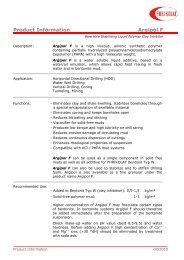
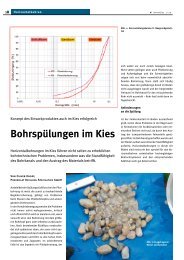

![Kapitel 1 - Phrikolat Produkte in Bearb [Kompatibilitätsmodus]](https://img.yumpu.com/24166745/1/190x135/kapitel-1-phrikolat-produkte-in-bearb-kompatibilitatsmodus.jpg?quality=85)
